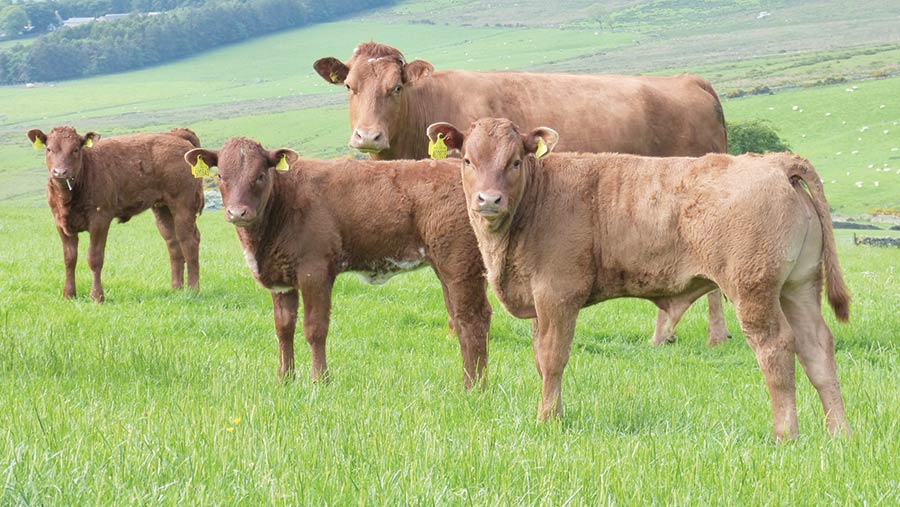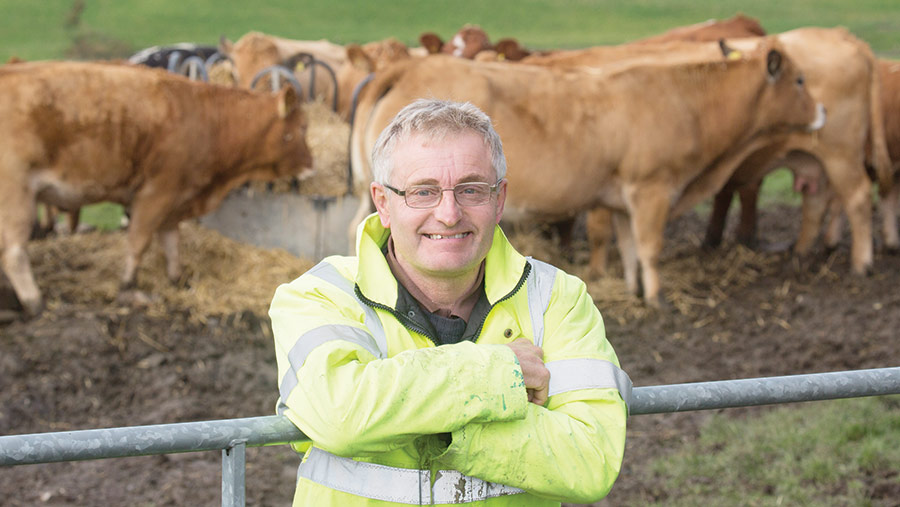Durham farm saves costs with grassland focus and weighing

Measuring and recording grass growth and weighing livestock more frequently has opened up cost-saving opportunities on an upland grazing farm.
David and Joyce Monkhouse of Low Houselop Farm, Tow Law, County Durham, are now looking at marketing cattle younger and grazing smaller paddock sizes where possible.
Originally from Boroughbridge, North Yorkshire, Mr Monkhouse moved from a county council tenancy in 2007, starting with 50 cows and 250 shearlings at Low Houselop.
The farm has bred hard-working stock. Last year the herd achieved a £472 gross profit margin per cow, putting the farm comfortably in the top 25% of all suckler herds on Farmbench, the AHDB’s costings programme.
A deer enterprise was added in 2017 to diversify income streams, and in September 2017 Low Houselop became an AHDB Strategic Farm.
“I grew up thinking about cost of production,” explains Mr Monkhouse. “Topping the mart is great if you can do it, but it’s about the costs that get you there that matter.
“Every year I learn and I am certainly not perfect. We have our successes and failures every year – it’s just about trying to improve.”
See also: How to assess cow efficiency with liveweight measurement
Low Houselop Farm
- 110ha of pasture overall, mostly Less Favoured Area plus fell rights
- 72ha of permanent pasture and 32ha rented
- 80 cross-bred suckler cows
- Limousin and Parthenaise bulls
- 550 ewes, crossing Cheviots and Scottish Blackface ewes to Border Leicester-cross Texels, with Charollais and Primera used as terminal sires
- 40 hinds producing deer calves for finishing
Rotational grazing
Pasture runs up to the fell boundary and ranges from about 860ft to over 1,000ft in the Durham Pennines.
Field sizes vary but are typically about 4-8ha. And, with the property not having mains water, the farm has struggled to rotational graze the cattle and sheep and subdivide pasture into paddocks.
However, a grazing trial (carried out as part of the farm’s involvement with the AHDB Strategic Farm project) has compared a 7.3ha block of pasture that was subdivided with a two-field 9.7ha block that was set-stocked last summer.
The land runs next to a natural water course and all paddocks in the field were supplied with water by dividing it up into long, thin sections running down to the stream.
The rotationally grazed field averaged covers of 3,340kg/ha DM, compared with 2,100kg/ha DM and 2,820kg/ha DM in the larger block.
This equates to being able to graze five more cows per hectare if grazing for seven days at a time on each hectare, explains veterinary nutritionist Debby Brown of Dugdale Nutrition, who is managing the Strategic Farm project with the Monkhouses.
By growing an extra 520kg/ha DM of grass each day, and with cows eating 16kg DM daily (2.5% of a 640kg cow’s bodyweight), the gains could lead to a shorter winter, less supplementary feeding in the shoulder months or possibly slightly higher stocking rates.
“Not everything works here,” explains Mr Monkhouse. “Calving at two and a really tight calving block don’t suit me, but dividing the paddocks up definitely does.”
Extra grass grown as a result of rotational grazing has allowed the number of ewes and lambs per acre to increase from five to eight.
Grass was measured with a plate meter whenever animals entered and left a paddock. Figures were stored on a programme called Pasture Management Software.
Weighing at weaning

David Monkhouse
The Strategic Farm project also involved weighing calves and cows and calculating the weight of the calf as a percentage of the dam’s weight at weaning (cow efficiency).
Previously, Mr Monkhouse didn’t weigh cattle, but the project showed that adding weigh bars to a handling system (at a cost of £1,500-£2,000) can show how hard cows are working.
The trial has revealed the superior efficiency of the cross-bred cows.
The herd is mainly based around Limousin suckler cows and Shorthorn/Limousin-cross cows, with pure Limousin cows also bred to a Parthenaise bull to produce fast-growing calves.
The cross-breds are slightly smaller and slightly more efficient (see table). They had a great year in 2017, when they reared 100% (calves weaned per cow put to the bull).
Mr Monkhouse says: “The Limousin and Shorthorn cross is clearly a good combination. I don’t know why there aren’t more Shorthorn breeders crossing a few for sale, I really like them.”
Going forward, this information will be used to find the cows that are the most efficient and look to retain heifers from them, thus improving the weaning efficiency of the herd.
Herd performance |
||||
|
Key performance indicator |
Limousin-cross Shorthorn 2017/18 |
Limousin 2017/18 |
Limousin-cross Shorthorn 2018/19 |
Limousin 2018/19 |
|
Cow weight at weaning (kg) |
640 |
680 |
656 |
665 |
|
Calf at weaning (200 days) |
287 |
305 |
282 |
267 |
|
Daily liveweight gain (kg/day) |
1.35 |
1.28 |
1.21 |
1.09 |
|
Weaning efficiency (%) |
42.6 |
39.1 |
42.9 |
40.3 |
Weighing in the winter
The Monkhouses have started selling youngstock to a private buyer months earlier than previously, after looking at weight gains and the cost of achieving those gains.
Bull calves used to be sold in March and heifers in late spring. However, now bulls are sold in January and heifers in March, saving on 90 days of store ration.
Each day the store ration of soya, minerals and barley (£200/t) costs £1.60 a head for 8kg of ration/day, including the cost of a visit from a mill and mix machine.
There are also six to seven silage bales and straw bedding every week to account for, with Mr Monkhouse calculating a rough wintering cost of £2 a head/day.
Selling earlier is a trade-off between saving feed and labour costs and selling smaller calves for less, he explains.
Mr Monkhouse is now considering selling bulls in December and heifers in January, depending on the customer’s requirements.
The numbers
89% Numbers of cows calved in the first nine weeks of calving
1.31kg Average daily liveweight gain of the Shorthorn-cross calves for the past two summers – 1.12kg/week more than the Limousin calves
87% Calves born alive per cow bulled for 2018
System
- Calving: 1 March to the end of May.
- Bulls: Typically bought as yearlings so they can be grown naturally and acclimatise to the farm. A budget of £2,000-£3,000 typically secures good young bulls for the farm. Each bull sires 15-20 cows.
- Haylage: One crop is taken in July, typically analysing at 50-60% dry matter, 11-12 crude protein and 9.5-10 metabolisable energy
- Creep feeding: Calves are fed a 17% protein pellet from July, with rolled barley mixed in.
- Housing: Pneumonia vaccinations are started in September and cattle and youngstock are housed in November.
- Weaning: A few days after housing. Calves fed silage and creep feed, backs are clipped, all cattle are weighed and cows, heifers and bulls are drafted separately.
- Turnout: Usually happens in mid-May after all calves have been born and cows have had a magnesium bolus and a general purpose (copper, selenium, iodine) bolus.
